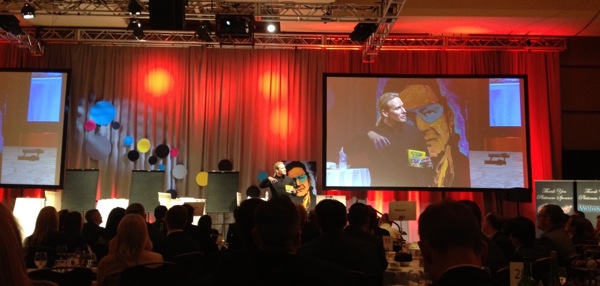 Erik Wahl recently was a keynote presenter at Western Michigan's Food Marketing Conference. I had absolutely no interest in the food marketing conference itself, but having become a recent fan of Erik's artwork and speaking, I found a way to attend his keynote and finally get a chance to see him perform live. The primary reason that I have been so interested with Erik Wahl is that he is an excellent communicator. And as a preacher who loves the art of preaching, there is a value in seeing an artist showcase his craft and try to learn a few tricks.
Erik Wahl recently was a keynote presenter at Western Michigan's Food Marketing Conference. I had absolutely no interest in the food marketing conference itself, but having become a recent fan of Erik's artwork and speaking, I found a way to attend his keynote and finally get a chance to see him perform live. The primary reason that I have been so interested with Erik Wahl is that he is an excellent communicator. And as a preacher who loves the art of preaching, there is a value in seeing an artist showcase his craft and try to learn a few tricks.
If you haven't seen any of Erik's work, you can find a video later in the post of one of his pieces.
3 Lessons on Preaching from Erik Wahl
1. You are an artist.
If you ask a room full of adults, "How many of you draw?," you will not likely get very many hands. The same would probably be true of preachers. If you asked a Kindergarten classroom this same question though, the results would be completely different. Something happens as we grow older, and we begin to believe we aren't artists. We believe we aren't creative. We've been told that certain things have to be done a certain way in order to get the results that you are expected to get. When it comes to preaching, I love looking at the sermon as a work of art. When I work on my sermon I want to actually believe that I'm creating a work of art that makes a difference.
[tentblogger-vimeo 35737101]
2. Timing is important.
When Erik was painting one of his pictures, he perfectly timed his painting so that as the music finished, he would spray paint an apple on the canvas, ask us to "think different" and rotate the canvas in order to reveal that the painting was Steve Jobs. When I preach, I spend a lot of time working on the content of my message and even specifically crafting the order of my content, but an area where I can improve in understanding the significance of the timing in how I say certain things. The rhythm, the pacing, the tone, and pauses all help communicate. And those are things that are easy to forget about and can only really be perfected by practicing.
3. Your talk doesn't end when you end.
As Erik neared the end of his keynote, he described the significance of social media and it's implications for all the people in the food industry. As he described the significance of social media, he also let the entire room know his plans of doing an "art drop" by giving a clue via Facebook at 10:01pm. The art drop is brilliant in and of itself, but engaging the audience by encouraging them to participate in this art drop was even more brilliant. This social media illustration would be experienced by the audience even after the keynote was finished and participants had left the building. What would our sermons look like if they didn't end when we prayed? What if our sermons engaged people still on Monday?
Who is someone that is not in ministry that you've learned some lessons about ministry from?
